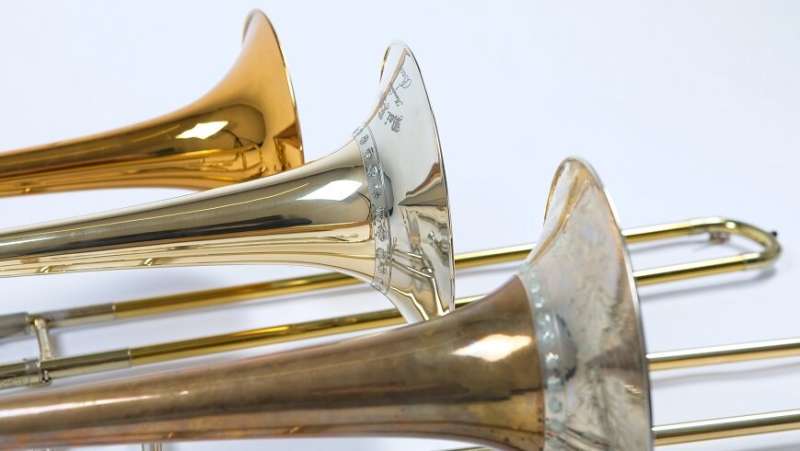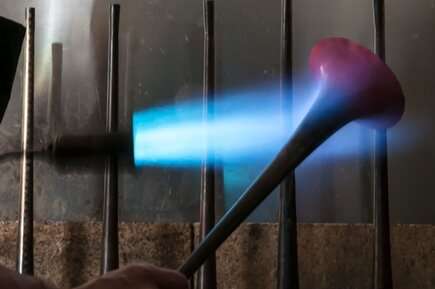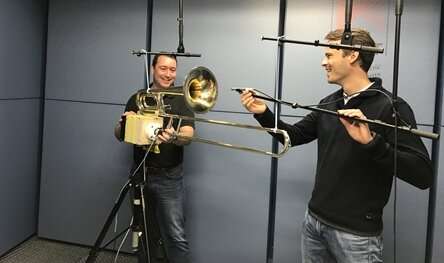Reproduction of historical trombones

There is a scholarly trend of playing ancient music as it was conceived by the composer. But where can rare historical instruments be found? One solution is fabricating exact copies of the originals. A team of Empa researchers is analysing such replicas with the aim of reproducing historical trombones with their typical sound.
Musicians and conductors of the classical music scene demand authenticity, and the Basel-based instrument maker Rainer Egger wants to deliver replicas of Romantic trombones. These instruments are special because of their dark sound, which allows the symbolism to come into its own in the compositions of that time. Empa researchers are also involved in the Innosuisse project "The Sound of Brass" at the Bern University of the Arts, where they analyze the material and sound of the historical originals—and compare the results with the first replicas. The project aims to show how replicas can be produced that are equal in sound to historical instruments—or even surpass them.
Egger, the implementation partner of the project, has specialized in historically informed instrument making and wants to revive the "German Romantic Trombone" from the 19th century. Brahms, Mahler and Bruckner may have written their compositions for these trombones, to which contemporaries attested a "fabulously soft and full tone". "Today's trombones sound different," explains Egger. He is convinced that construction, material and manufacturing techniques are responsible for the unique sound. However, this has not yet been scientifically proven.
Empa researcher Martin Tuchschmid from the Empa Laboratory for "Joining Technologies and Corrosion" therefore investigated 64 romantic trombones. He used mobile energy dispersive X-ray fluorescence spectrometry to determine which materials instrument makers had worked with at the time—a non-destructive method used to investigate metallic materials in construction and industry. This resulted in a "material catalog" that lists the alloys used in meticulous detail. For example, one learns that different parts of the trombone such as the wreath, bell and slide were often made of different materials. Brass, the reddish copper alloy tombak and nickel silver, a copper alloy with nickel and zinc, were frequently used. "The analyses resembled an archaeological excavation," says Tuchschmid. It was simply not known what the historical trombones were made of.

Instrument maker Egger then selected suitable materials and rebuilt the trombones by hand. Egger's hypothesis: The replicas should sound warmer, darker and softer than modern instruments. This can be physically measured in the form of sound frequencies and amplitudes. To ensure that the sound in such experiments is not influenced by the musician's playing technique, Egger, together with experts from Empa's Acoustics and Noise Reduction Department, also developed a device that stimulates the air column in the trombone in a controlled manner.
The Empa researchers analyzed the sound of the replicas and originals in a low-reflection laboratory. They used a scanning laser Doppler vibrometer to determine how the material behaved while playing. Their conclusion: material, production technique and design of the instrument have a clear influence on the sound and structural dynamics of the trombone. "For the first time, we were able to show that the standing sound waves in brass instruments interact with the material via resonances, which significantly influences playability and sound," explains Empa acoustic researcher Armin Zemp.
But that's not all; the analyses also revealed indications for instrument making, such as the ideal position for the braces as well as specifications for the thermal treatment of the material. "When the sheet is annealed, internal stress is relieved. As a result, the sound of the trombone becomes much softer because the vibration behavior of the material changes," explains the acoustic researcher. With regard to material composition, the analyses showed that harder alloys with a higher zinc and nickel content result in instruments with higher sound power levels. "The overall sound of a trombone is influenced by many individual parameters. The new data can now be incorporated into historically informed instrument making," says Zemp.
The aim is to generate the typical historical sound with perfect replicas. Initial reactions from experts show that this tricky task is likely to succeed. Ian Bousfield, lecturer for trombone at the Bern University of the Arts, has already had the opportunity to play the first replicas at concerts with the Biel Solothurn Symphony Orchestra. "The audience thought that the replicas would sometimes even sound more expressive than the original," he says. He was initially skeptical as to whether the quality of a legendary romantic trombone could be recreated. "But after the analyses of the replicas, I'm sure we're on the right track."
Interview with Ian Bousfield, trombone lecturer at Hochschule der Künste in Bern
Playing compositions with original instruments from the appropriate epoch is in vogue. Ian Bousfield, trombone lecturer at Hochschule der Künste in Bern, explains what access to reconstructed instruments with historical sound means to him.
Why is it interesting for musicians to play on historical instruments?
If you ask yourself what life was like in a different era, you can reconstruct history piece by piece with texts and objects. But with historical instruments we get another impression of history, namely its sound. We can also learn how Brahms, Bruckner or Mahler imagined their music when they created their compositions based on the sound of the instruments at their time. And finally, historical information results in an appreciation of the development music has undergone over the centuries and a better understanding of how it has evolved to this day.

You have played on 52 historical originals and on replicas from the "The Sound of Brass" research project. What is your impression?
First, we had to find out what defines the sound of the German Romantic Trombone altogether. Next, a modern interpretation of this sound was to be created in new instruments. That's not easy, since the originals had been played for 150 years, had certain traces of use and had developed their own "personality". Moreover, the expectations of today's musicians are quite different. In the past, musicians used different instruments for different pitches, i.e. alto, tenor and bass trombones. Today, the instrument is expected to produce the entire register of these three types of trombones. Thus, it is difficult to draw a comparison. Nevertheless, I think the replicas remain true to the historical sound.
For which musicians are these replicas suitable?
Personally, I find it tremendously important for young musicians to have access to such instruments in order for them to be able to develop their own ideas of the sound of Romanticism. The replicas are also interesting for professional musicians playing in an orchestra that wants to create a certain sound. I know that the Romantic Trombone is a highly sought-after instrument for many orchestras. And now there will be authentic and durable replicas that match this traditional sound.
The interview was conducted by Adrian von Steiger from Hochschule der Künste in Bern and "The Sound of Brass" project manager.



















